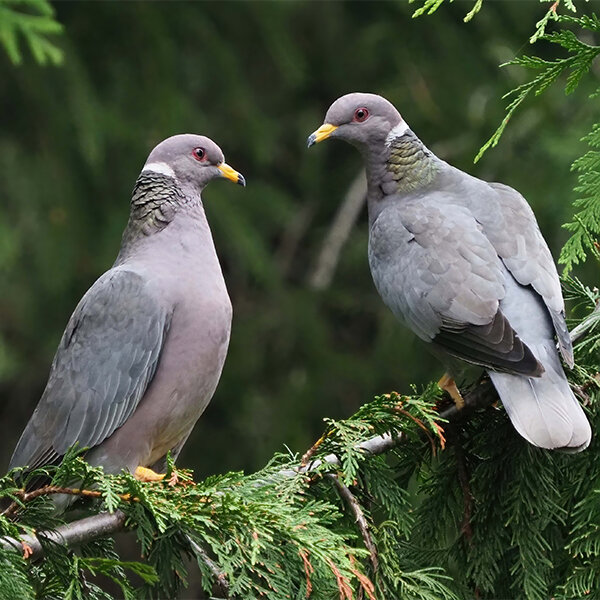Bird of the Month: Band-tailed Pigeon
Written by Andy McCormick
Andy McCormick, Volunteer and Former Board President of Eastside Audubon
A forest pigeon that also likes to come to feeders, the Band-tailed Pigeon is the closest genetic relative of the extinct Passenger Pigeon.
The Band-tailed Pigeon is a large grey pigeon that is both longer and bulkier than the more common Rock Pigeon (Columba livia). It has a long neck and a dome-like head. The back of the grey neck is marked by a band of iridescence green topped off by an easily-seen white crescent, both of which are absent in juveniles. The tail is long and dark with a wide pale band at the tip. The breast of the male often has a pinkish-purplish hue.
The call of the Band-tailed Pigeon is a low (uh) whooo (pause) (uh) whooo, which is repeated several times, and can be mistaken for that of an owl (Dunne). While feeding they can make a guttural grunt which may be a response to crowding. Calls, photos, and videos of the Band-tailed Pigeon are available at The Macaulay Library.
PACIFIC COAST SPECIALTY
The Band-tailed Pigeon has two distinct populations. The coastal subspecies breeds from Southern British Columbia through Southern California generally west of the Cascades and splits in California to the Coastal Range and the Sierra Nevada. This populations winters in the Southwestern United States. An interior population breeds in the mountains of the four-state area of Colorado, Utah, Arizona, and New Mexico, and western Mexico. The Band-tailed Pigeon also breeds and winters south through Mexico and the mountains of western South America (Keppie and Braun).
The Band-tailed Pigeon was placed in the genus Patagioenas, from the Greek, patageo, meaning “to clatter” and oinas meaning pigeon (Wikipedia). The reference is most likely to the rush of sound from a flock as they take off with their wings clapping together. The species epithet fasciata, references its tail band, from the Latin fascia, a ribbon or band (Holloway).
Band-tailed Pigeon
Scientific Name: Patagioenas fasciata
Length: 14.5”
Wingspan: 26”
Weight: 13 oz (360g)
AOU Alpha Code: BTPI
FOREST NESTER
Conifer forest habitat is the preferred environment of the Band-tailed Pigeon. In Washington the western slope of the Cascades provides ideal Douglas and silver fir, western red cedar, and western hemlock trees. These pigeons forage on acorns, when they are available, and other seeds, and add cherries, huckleberry, elderberry, and Pacific madrone to their diet (Keppie and Braun). They will venture to urban and suburban areas where there are large trees and readily visit feeders which they can empty in a day.
As most pigeons and doves, the Band-tailed builds a nest of loose sticks that looks unable to hold them. Typically, one egg is deposited and both parents will incubate it and then feed the nestlings. For the first few days the young thrive on “pigeon milk,” a milky substance rich in protein and fat which is secreted from glands in the crop of the adult. As the young age, the pigeon milk is mixed with regurgitated digested food. The young leave the nest in about three weeks but continue to be tended to by adults (Kaufman).
CONSERVATION AND MANAGEMENT
Previous sport and market hunting of Band-tailed Pigeons precipitated a decline in their population causing advocates to become fearful of a repeat of the eradication of the Passenger Pigeon. After hunting limits were introduced in the 1930s, the population recovered to some degree. However, the species is still in decline. In response, British Columbia, Washington, and a few other states have now completely banned hunting of the Band-tailed Pigeon (Keppie and Braun).
Recovering banded Band-tails during ongoing research has revealed that these birds are long-lived. In 14 years of a 17-year banding and recapture project researchers found at least one individual greater than 10 years of age. The longest-lived Band-tailed in Washington was over 18 years of age (Keppie and Braun). Long life is a trait that will help Band-tails maintain their population. Each added year allows an adult pair the opportunity to produce more offspring during their lifetime. They can have three broods per season, but they produce only one egg per brood. We are fortunate that this forest pigeon is doing well in the Pacific Northwest.
Photo credit Andy McCormick. References available upon request from amccormick@eastsideaudubon.org.



